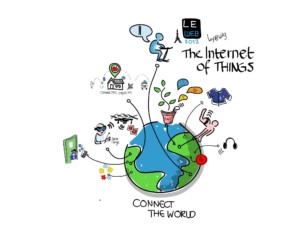By Peter Hovard
Smart devices are assuming increasing roles in our lives. Wearables are tracking health behavior, telematics devices in cars are monitoring driving, and devices in homes are managing everything from energy to food supplies.
These software- and sensor-equipped devices, which are connected to the internet, other devices, and people, are collectively developing what we know today as the Internet of Things (IoT).

For consumers, a real benefit of IoT is how products incorporating the technologies can make a variety of personal tasks simpler and more convenient. Monitoring personal fitness and health are just the beginning: smart refrigerators can keep running grocery lists, and mobile apps can manage and monitor household energy consumption. Just picture asking Alexa to change your shower temperature.
For business organizations, the chief value of IoT so far has been data collection. Increasingly, however, the value is becoming its potential ability to change user behaviors. For example, a health insurance company may want to use IoT technology to help customers behave in a healthier fashion to help them stop smoking/vaping or change their diets, and thus improve overall health and ultimately reduce their claims costs.
Being able to show users objective data about their behavior is tantalizing territory for those interested in behavior change. But enabling such changes is rarely simple, and IoT, although an increasingly useful functionality, is not necessarily the panacea.
That being said, used right, IoT can be a highly useful framework for behavior change. Adding behavioral science thinking and techniques to the product development framework can raise its potential even further.
The three main challenge areas in IoT-based products that behavioral science can help and strengthen to fulfill the products’ behavioral change potential are: 1) adoption and engagement 2) disentangling the effects of self-selection (higher levels of engagement from those who are already motivated) from behavior change and 3) bringing behavioral science to a product’s interface and proposition design to make its behavior change facility more likely and effective.
Adoption and Engagement Are Behavior Change Challenges
The first challenges for IoT-based behavior change are user adoption and the facilitation of engagement. Adoption of any new technology tends to follow a bell-shaped “diffusion of innovation” curve, with a small number of early adopters leading the way for most of the population.
But various psychological factors can influence adoption, such as perceived usefulness and ease of use, social influence, hedonic motivation (expected enjoyment), perceived value for money, as well as habit. This is important ground for behavioral scientists: By understanding users’ contexts and needs, messaging strategies and propositions can be designed that encourage uptake.
Ongoing engagement with a product’s specific technology is another important consideration. Essential factors such as usability, usefulness, novelty, and gamification must be designed for. Ultimately, however, behavioral scientists are needed at the design stage to identify the real user goals that motivate behavior, as well as the various environmental (e.g., time constraints) and cognitive (e.g., forgetting, competing goals) barriers to engagement.
There is evidence from the health tech industry that the adoption and engagement challenge is far from superficial. Estimates vary, but in general, health and fitness apps have been shown to achieve relatively low engagement and retention rates. While the wearables market has grown steadily, some estimates report user retention rates of only 7% beyond the first three months. Similarly, academic trials have demonstrated significant barriers to the adoption of wearable devices, particularly with certain groups, such as the elderly.
IoT technology is quietly on its way to becoming a default feature of our lives. As we mentioned earlier, telematics is integrated into modern cars, and the U.K. government has set targets for energy suppliers to roll out smart metering. Health monitoring is also an increasing feature of consumer products: Apple recently released a report suggesting that enabling consumers to monitor their health via its technology is a big aspect of its future vision.
Nevertheless, much work will be needed from marketers, designers, and behavioral scientists to create the sort of engagement with IoT products that will enable full behavior change potential to be realized.
Separating Self-Selection and Behavior Change Effects
A second consideration is who adopts and engages with the technology. Adoption and engagement numbers likely over-represent certain population subsets. Early-stage adopters of IoT products, for example, are generally the already-motivated. Fitness watch owners are apt to be those with at least some interest in fitness. One example of this comes from a recent study showing that those with or at risk of cardiovascular disease are less likely to use wearable devices than the population average. Similarly, unsafe drivers are less likely to opt for telematics trackers, and smart home technology owners are generally interested in energy efficiency.
While lab-based randomized control trial studies – which control for these self-selection effects – show that well-designed IoT products can influence behavior, outside of the laboratory, self-selection effects ultimately mean that IoT products cater to those with latent motivations.
That is not to say IoT products can’t make behavior changes more likely, more robust, or faster for those groups. But behavioral scientists should consider that in the real world, disproportional uptake of IoT products by motivated subsections of a population may mean that it caters mostly to those who may need it least. Unpicking these dynamics from one another is an important task for behavioral scientists in assessing the true behavior change potential of IoT products.
Motivating Sustained Behavior Change Through Interface and Proposition Design
Finally, behavioral scientists will be needed to help organizations turn behavioral data collection into behavior change. This can be accomplished by designing interfaces, propositions (such as incentive programs), and messages that motivate users. Behavioral scientists can help explore IoT users’ real goals and design and tune propositions that support those motivations.
Designers and behavioral scientists can work together to implement recognized behavior change techniques with a solid evidence base in user interfaces. This means going further than surfacing behavioral data for self-monitoring. Similarly, while gamification is fashionable, an important task for behavioral scientists will be identifying and avoiding the superficial tactics that can creep into a product’s design disguised as behavior change techniques (we’re looking at you, meaningless performance badges!). Instead, behavioral scientists can work with designers to deploy gamification tactics grounded in behavioral theory and supporting users’ real goals.
There is evidence that being monitored can change behavior; a phenomenon known as the Hawthorne Effect (which was first identified as a research methodology bias). However, the magnitude of the effect depends on people’s perceptions of being observed for a period of time. Hence, ongoing engagement with the technology is likely necessary for the effect to occur, even to remind users that they are being monitored and to bring it to the top of their minds. By designing for engagement and using recognized behavior change techniques, behavioral scientists can help unleash the potential of IoT interface and proposition design.
Conclusion: Deploying Behavioral Science to Realize the Promise of IoT Technology
The potential for IoT technologies to support behavior change is clear. The sheer ability to collect data relating to a range of behaviors opens the door for numerous recognized behavior change techniques such as self-monitoring and gathering performance feedback. But technological development is often accompanied by panacea thinking: being overly optimistic about the impact a new technology will have on an outcome. Behavioral scientists will be useful for organizations planning to use IoT technology to change behavior.
To do this well will involve the three considerations discussed.
By involving behavioral science in the development of these technologies, organizations can extract more value from their products, offer more value to consumers, and understand the complex dynamics of influencing human behavior through technology.
This article was edited by Carina Müller.

